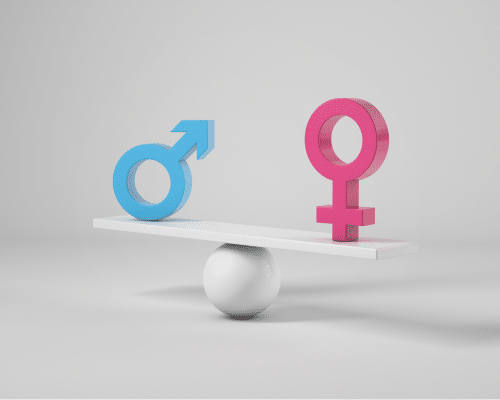The Equality Act 2010 legally protects people from discrimination in the workplace and wider society. This means it is illegal to treat someone unfairly because of who they are, including their gender, race, age, sexual orientation, disability, religion or beliefs. There are many types of discrimination, however, this article is going to focus on gender discrimination. Examples of gender discrimination are employees receiving unequal pay or benefits compared to others and fewer career opportunities because of their gender.

It is important employers and employees can notice discrimination within their company, know how to avoid it and how to correct it if it does occur. If discrimination is taking place, it can negatively impact an employee’s mental health, leading to conditions such as anxiety and depression. This can lead to high staff turnover, poor work performance, and a toxic workplace.
Types of gender discrimination
Our Women in Tech survey showed a staggering 76% of the respondents said that they have experienced gender bias or discrimination in the workplace at least once. Whilst these are disappointing figures, 61% of people surveyed said that their organisation are actively working to improve this.
But what is gender discrimination?
Below are the four types of sexual discrimination that the law defines:
- Direct discrimination – Treating someone less favourably because of their gender
- Indirect discrimination – When an employer imposes a rule that gives either the men or women an unfair disadvantage
- Harassment – Unwanted behaviour relating to a person’s gender, unwanted sexual behaviours or actions that create an intimidating, hostile, degrading or humiliating environment for that person
- Victimisation – You are treated poorly because you have complained about discrimination or supported someone that has
Whilst discrimination can be intentional, we can also see the effects of unconscious gender bias on the inequality of men and women in the workplace. The definition of unconscious bias is the unintentional mental associations based on factors, such as gender, which affects decision-making. Unfortunately, everyone holds unconscious biases about individuals that we aren’t aware of which causes underlying attitudes to form, causing us to make judgements before having all the information. Supporting this, the ILO Bureau for Employers’ Activities surveyed many companies on the top barriers to women’s leadership. Five of the barriers to women’s leadership were related to discrimination and unconscious gender bias. The respondents also cited stereotypes against women and inherent gender bias in recruitment and promotion.
How to spot gender discrimination in the workplace
The gender pay gap is a clear way to see gender discrimination in the workplace, as this shows the monetary earnings between male and female employees. In March 2022, the UK average was at 14.7%, which is a decrease from 18.2% in 2018-19, however, we are still a long way from the gap being closed. Unfortunately in the tech industry alone, this number is higher at 16%, showing more of a gender divide in the industry compared to others. Shockingly, 78% of large organisations admitted to having a gender pay gap in the technology sector with males earning more than females.
Whilst this can be due to women taking more part-time jobs than men or more men applying for higher-paid roles, it can also be because of hiring and promotion decisions in the workplace that are more favourable towards men, or employees not helping women return to work after a career break and getting their skills back to where they were so they have to go for lower-paid jobs. Within tech in particular, the gender pay gap can also be due to so many women leaving the industry due to discrimination and the male-dominated environment.
Adopting new practices and policies, such as having shared parental leave (SPL) is one of the ways companies can help to close the gender pay gap and help retain women in their workforce. A study by UK-based Institute for Fiscal Studies found that on average, women in paid work earn approximately 18% less than men, with the gap only increasing when they become mothers. When they reach the 12th year after their first child, this gap rises to 33%. Whereas, if each parent takes the same time off and takes the same pay, the difference won’t be as great. Research has also shown that by 20 years after the birth of their first child, women have, on average, been in paid work for four years less than men and have spent nine years less in paid work of more than 20 hours per week. This can be a huge contributing factor to the pay gap and will cause women to not feel as valued as men. This will also make it more likely that they will be overlooked for promotions, increasing the inequality between genders.
If a company is regularly favouring men over women for promotions when they have the same skill level there may be discrimination coming into play. Instead, companies should be helping all members of staff to gain promotions, whether this is through training or mentoring. With a lack of opportunities for progression being one of the main reasons so many women leave tech, it is important employers have just as many prospects for women as they do for men.
How to deal with workplace gender discrimination
In an ideal world, there would be no discrimination but unfortunately, more than 3 in 4 of workers say they’ve experienced discrimination at work, therefore it is crucial that employees know what to do if they face this. Firstly, try not to feel ashamed or embarrassed as it is not your fault, and the law is behind you! Secondly, the best course of action is to make a complaint to the person that deals with grievances at your workplace which is usually HR or your line manager and explain details of what has happened whether it is about one individual or multiple people. You might be able to then negotiate with your employer to reach an agreement, called settling. A trained mediator may also be beneficial as they will help you and your employer reach an agreement before legal action.
However, if you are unable to deal with this internally, the next step would be to use a grievance procedure by lodging a letter of grievance and it is also good to let your doctor know so you can discuss the impact this has had on your mental and physical health if appropriate. Having this on your medical records can become important if you go to an Employment Tribunal (ET) as it will mean you can provide medical evidence.
However, before you make a claim to ET you must contact Acas for an ‘early conciliation’ (EC) service whichis a free service where Acas can help you try to resolve the issue. For your case to be looked at you must contact Acas within 3 months, minus one day from the date of the incident or 3 months minus one day from the date of the last incident. If by the end of this you still cannot reach an agreement with your employer and/or the person that harassed you, Acas will issue an EC certificate and you have at least a month from the date the EC certificate was issued to make an ET claim. It is good to start with contacting EC as this “stops the clock” on the normal time limitation period for making an ET claim which also is 3 months, minus one day, from the date of the incident or 3 months, minus one day, from the date of the last incident if it was a period of harassment. You can read more about how to handle workplace discrimination at Citizens Advice.
You can read more on how to deal with different types of discrimination here.
How employers can support staff and avoid gender discrimination towards women
Changing the way you interview and hire candidates is one way to help reduce discrimination. For example, blind hiring is when employers hide information about the applicants including gender, name, religion etc. This means they are chosen based on their skills and experiences and not because of unconscious or conscious bias. Supporting this, Kedar Iyer, creator of the software company GapJumpers, recognized a number of talented coders had their job applications overlooked because they didn’t attend prestigious colleges. Therefore, he produced software that hides the candidates’ names, faces and personal information during the initial hiring stages. Subsequent company numbers suggest that compared to standard resume screening, it’s use increases the chances of minority and female applications being offered a first-round interview by around 40%, in turn increasing diversity and equality. Being able to base a hire solely on the person abilities also reduces the chances of a bad hire, saving the company time and money.
Another effective way to try to fight against discrimination is to have employee networks which are created voluntarily by colleagues with similar backgrounds or beliefs. For example, Women’s Networks can connect women from different departments within an organization, creating a safe space where they can discuss topics they might have in common such as childcare, work-life balance, women’s health and they can get advice on how to deal with problems at work including promotion opportunities and discrimination. This helps to build strong connections with colleagues and increase employee’s confidence which will encourage them to speak up if they are having a problem at work, such as being discriminated against. You can find more about starting a women’s network in your workplace here.
In addition to employee networks, male allies are also an helpful way to make women feel included and heard in the workplace. Allies are people that will use their personal privilege to speak up on behalf of their unrepresented colleagues, for example females in the male-dominated tech industry. This may be by trying to promote change to hiring methods and any policies or protocols that favour men, or speaking up when they see discrimination in the workplace.
Furthermore, employers can help by supporting women in the workplace is being helping those that have had a career break and are wanting to return to work. Childcare and maternity leave being the most common reasons for this. Helping these women get back to work will help improve the gender pay gap, improve gender diversity and will also mean the company isn’t having to train someone up from scratch as they will already have skills from working before. Returnship programmes are an effective way to do this. These can last from anywhere between 10 weeks and 6 months and they are designed to help those that have taken a career break get back to their senior roles through training and mentorship. This is a great, low-risk way for both the employer and employee to make sure this is a good fit before going permanent.
Ensuring you have training programmes for the women in the company to help them achieve more senior roles will also help to build equality and help to close the gender pay gap. This will also make their female employees feel included and supported, improving work performance and job satisfaction. Promoting more women into senior roles will also mean young women or women looking for a career change have role models to look up to in the tech industry and are more likely to join the tech industry, reducing the ‘boys club’ environment and gender discrimination.
Having employee benefits also will help retain women in the industry and make them feel valued. In our Women in Tech survey the top incentives for women were flexible/remote working, company training, above-average annual leave allowance, bonus scheme and health insurance. These benefits help employees to have a good work-life balance and help accommodate those with children and other at home responsibilities. If people feel appreciated at the job, they are more likely to want to perform well and be motivated, benefiting both the employer and employee. Having good miscarriage and pregnancy loss support policies also will show female employees that their employer cares about their well-being, both mentally and physically making it more likely they will want to stay at their job. Supporting this, Wildgoose found that underappreciated women at work are 34% more likely to suffer from mental health problems than their male counterparts as a result of feeling undervalued and they were also more likely to lose interest in their job, with 40% of employees becoming less productive after suffering from a lack of recognition.
Lastly, it is important to make sure there is open communication in the organisation and that people feel comfortable to bring up any problems they are having or to ask for any advice. This will include feeling like they can come to a line manager/HR if they have faced any discrimination or know anyone that has, and they can receive advice on what to do. If someone feels isolated and like their voice isn’t heard, they are more likely to suffer in silence and end up leaving their job, therefore it is important that all employees and company owners do their part in helping everyone to feel supported and like they belong.
You can read more about workplace discrimination here.






